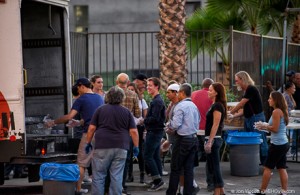
“Help that doesn’t help,” said Courtney Konagi, the street outreach coordinator for People Assisting the Homeless (PATH). “Giving money, giving food to homeless people. That hurts our efforts so much.”
Other homeless service agencies agreed, explaining that when residents give money or food to homeless people, it allows them to stay on the streets rather than seek other help available to them.
Similarly, law enforcement agencies periodically doing “clean ups” where they chase homeless people away from a specific area also hinder outreach efforts because convincing people to come in for services often takes time.
“We’re cultivating these relationships, but after a sweep, we lose months and sometimes years worth of efforts,” explained Rudy Salinas of Housing Works, an agency which deals with chronically homeless people. “We have no idea where the people have gone. All that work to build a relationship, getting them to trust us, is lost. It may be months before we ever see them again.”
The presence of homeless people has become a bigger issue in recent months with an effort by residents of an area north of Melrose Avenue and east of La Brea Avenue to end distribution of food by the Greater West Hollywood Food Coalition from a truck at Sycamore Avenue and Romaine Street.
The effort is being led by Los Angeles City Councilmember Tom LaBonge, who has said that groups that provide meals “provide a valuable service” but can cause “negative impacts to surrounding communities.”
The people most resistant to getting help tend to have mental health issues, substance abuse problems or don’t do well in structured environments like a shelter where they must follow rules and adhere to a curfew, explained Katie Hill, PATH’s programming manager, to the homeless services subcommittee.
The greater Los Angeles area is the nation’s “homeless capital,” as Hill phrased it, with an estimated 54,000 homeless people. PATH sends its outreach team daily to various “hot spots” where homeless people gather across Los Angeles County. Those places include West Hollywood’s Plummer Park, a favorite since it has plenty of open space and easy access to restrooms.
The homeless population is lowest at the beginning of the month since people often get Social Security or disability payments and can afford a motel room.
Even thought police officers and sheriff’s deputies can take someone to a shelter, homeless people with outstanding arrest warrants are reluctant to approach them for that help, fearful they’ll end up in jail instead.
